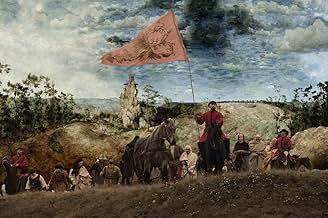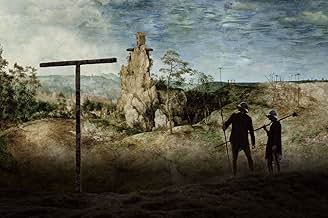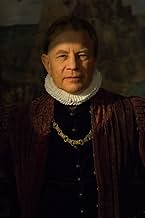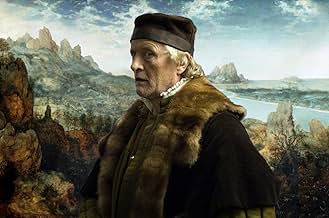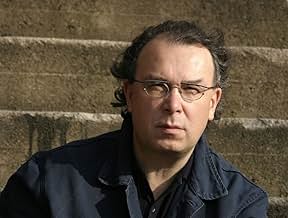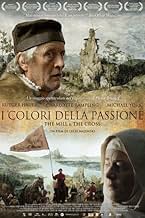NOTE IMDb
6,8/10
4,6 k
MA NOTE
Ajouter une intrigue dans votre langueThis movie focuses on a dozen of the five hundred characters depicted in Bruegel's painting. The theme of Christ's suffering is set against religious persecution in Flanders in 1564.This movie focuses on a dozen of the five hundred characters depicted in Bruegel's painting. The theme of Christ's suffering is set against religious persecution in Flanders in 1564.This movie focuses on a dozen of the five hundred characters depicted in Bruegel's painting. The theme of Christ's suffering is set against religious persecution in Flanders in 1564.
- Réalisation
- Scénario
- Casting principal
- Récompenses
- 10 victoires et 7 nominations au total
Avis à la une
The Mill and the Cross is a painting (so not a lot of plot!) come to life and it is unlike any movie I have ever seen before (and I have seen a few)! Directed by Polish filmmaker, Lech Majewski, it is a recreation and interpretation of the famous 1564 painting by Pieter Bruegel, "The Way to Calvary".
Glacially-paced and nearly-silent (at first) ... one film critic (Stephen Cole of "Globe and Mail") said that this film's detractors will likely lament that watching this "is like watching a painting dry" (a point I can understand some having). If it doesn't grab one's interest early-on -- the film's opening is the painting coming to life and than slowly drying back onto the canvas -- there is no point in watching it.
Another film about the inspiration of a painting (that I loved) -- The Girl with the Pearl Earring -- told a possible story of how a Vermeer masterpiece came into being AND each scene was as lovely as a painted picture. Here each scene looks like a painting as well; but this story isn't necessarily one about a "what-if" (although as a film it technically is). Instead, The Mill and the Cross pretends to show us THIS painting (not the inspiration behind it) as it is being painted.
The painting is of the re-imagined crucifixion of Christ in 16th Century Flanders while the region is under BRUTAL Spanish occupation. As Bruegel (Rutger Hauer - Batman Begins, Hobo with a Shotgun, Blade Runner) draws and explains his painting, the scene comes to life so that the audience sees what Bruegel "sees". The premise and style are highly unusual but I appreciated the delicate take (layer-upon-layer of computer imaging) of telling this story.
The Mill and the Cross isn't content with looking at a piece of art -- this film is about experiencing it which is rather marvelous as the Flanders countryside comes to life (and it is as if the audience has stumbled upon the same setting/scene as Bruegel). We get bits and pieces of story but no major plot other than the painting and its scenes/images coming to life.
This wasn't a favorite of mine by any means; but I do like the originality of it and anybody with a serious interest in art might want to check it out.
Glacially-paced and nearly-silent (at first) ... one film critic (Stephen Cole of "Globe and Mail") said that this film's detractors will likely lament that watching this "is like watching a painting dry" (a point I can understand some having). If it doesn't grab one's interest early-on -- the film's opening is the painting coming to life and than slowly drying back onto the canvas -- there is no point in watching it.
Another film about the inspiration of a painting (that I loved) -- The Girl with the Pearl Earring -- told a possible story of how a Vermeer masterpiece came into being AND each scene was as lovely as a painted picture. Here each scene looks like a painting as well; but this story isn't necessarily one about a "what-if" (although as a film it technically is). Instead, The Mill and the Cross pretends to show us THIS painting (not the inspiration behind it) as it is being painted.
The painting is of the re-imagined crucifixion of Christ in 16th Century Flanders while the region is under BRUTAL Spanish occupation. As Bruegel (Rutger Hauer - Batman Begins, Hobo with a Shotgun, Blade Runner) draws and explains his painting, the scene comes to life so that the audience sees what Bruegel "sees". The premise and style are highly unusual but I appreciated the delicate take (layer-upon-layer of computer imaging) of telling this story.
The Mill and the Cross isn't content with looking at a piece of art -- this film is about experiencing it which is rather marvelous as the Flanders countryside comes to life (and it is as if the audience has stumbled upon the same setting/scene as Bruegel). We get bits and pieces of story but no major plot other than the painting and its scenes/images coming to life.
This wasn't a favorite of mine by any means; but I do like the originality of it and anybody with a serious interest in art might want to check it out.
The Mill and the Cross (2011)
The Polish film "The Mill and the Cross" was co-written and directed by Lech Majewski It stars Rutger Hauer as Pieter Bruegel, and co-stars Charlotte Rampling and Michael York.
The film consists of an attempt to bring to life Bruegel's 1564 painting, "The Procession to Calvary." I have seen this painting in the Kunsthistoriche Museum in Vienna. Once you've seen it, you don't forget it, because it is filled with people and action. (Although, in the painting, Jesus has just collapsed under the weight of the cross, so, in a sense, action has been frozen for a few seconds.)
The painting is also remarkable for a very strange symbol--a windmill placed high atop a stony crag. In the film, Bruegel explains that the miller looks down from his mill and sees everything that is happening below, just as God looks down from heaven and can see everything. So, the mill and the miller work symbolically. However, in a practical sense, the mill would never be that high on an large, steep, stony crag. If a mill were really in that location, no one could bring the wheat to the mill or take away the flour.
The other dominant vertical structure is a cartwheel, raised high on a long pole. This was the device used by the Spanish rulers of the Netherlands to execute and display prisoners. The prisoner was tied to the wheel, and the wheel was hoisted far up in the air. The device prevented anyone from helping the person--if alive--or removing the body. Only the carrion birds could reach the body, which they did, with predictable results.
Technology in the 21st Century makes everything possible, so it's no surprise that the painting is reproduced in the film in a real landscape. Sometimes all the figures are frozen, but other times you can see a cow moving or some other action taking place. The special effects are routine by now, but the manner in which they are used is not routine.
We really have the sense that we are looking at a landscape, and the artist is putting it down on canvas before our eyes. This is a highly creative way to look at life the way an artist sees it, and then look at the way life is transformed and committed to canvas.
We saw this film on the large screen at the excellent Rochester Polish Film Festival. It really will work better in a theater. However, if that's not an option, it's worth seeing on DVD.
The Polish film "The Mill and the Cross" was co-written and directed by Lech Majewski It stars Rutger Hauer as Pieter Bruegel, and co-stars Charlotte Rampling and Michael York.
The film consists of an attempt to bring to life Bruegel's 1564 painting, "The Procession to Calvary." I have seen this painting in the Kunsthistoriche Museum in Vienna. Once you've seen it, you don't forget it, because it is filled with people and action. (Although, in the painting, Jesus has just collapsed under the weight of the cross, so, in a sense, action has been frozen for a few seconds.)
The painting is also remarkable for a very strange symbol--a windmill placed high atop a stony crag. In the film, Bruegel explains that the miller looks down from his mill and sees everything that is happening below, just as God looks down from heaven and can see everything. So, the mill and the miller work symbolically. However, in a practical sense, the mill would never be that high on an large, steep, stony crag. If a mill were really in that location, no one could bring the wheat to the mill or take away the flour.
The other dominant vertical structure is a cartwheel, raised high on a long pole. This was the device used by the Spanish rulers of the Netherlands to execute and display prisoners. The prisoner was tied to the wheel, and the wheel was hoisted far up in the air. The device prevented anyone from helping the person--if alive--or removing the body. Only the carrion birds could reach the body, which they did, with predictable results.
Technology in the 21st Century makes everything possible, so it's no surprise that the painting is reproduced in the film in a real landscape. Sometimes all the figures are frozen, but other times you can see a cow moving or some other action taking place. The special effects are routine by now, but the manner in which they are used is not routine.
We really have the sense that we are looking at a landscape, and the artist is putting it down on canvas before our eyes. This is a highly creative way to look at life the way an artist sees it, and then look at the way life is transformed and committed to canvas.
We saw this film on the large screen at the excellent Rochester Polish Film Festival. It really will work better in a theater. However, if that's not an option, it's worth seeing on DVD.
An art movie about the 16th century's arts. It was based on the book of the same name which details the landscaper Pieter Bruegel's painting 'The Procession to Calvary'. A movie specially made for classical painting lovers.
The movie had very less talkings and everything should be learnt by watching the pictures which depicts painting like series of frames. So there's nothing much to talk about the movie. One of the best ever production designs. Frankly, I was less enjoyed due to lack of knowledge about Bruegel, but glad I saw it and come to know few things about 1500s culture through his paintings.
After all, I was not stranger to 'The Procession to Calvary' only by a few weeks before watching this movie. Recently I saw a movie called 'Museum Hours' and it helped a bit to understand this movie. In that movie a guide, an expert briefs in a scene about this painting and the reason behind it.
It was a very unique movie, which still won't exactly portray as it had happened. A glimpse about the idea of it might have been like that. More like an imaginary world created behind the magnificent art work. Not suitable for all, especially those who watch movies for entertainment should stay away from it.
The movie had very less talkings and everything should be learnt by watching the pictures which depicts painting like series of frames. So there's nothing much to talk about the movie. One of the best ever production designs. Frankly, I was less enjoyed due to lack of knowledge about Bruegel, but glad I saw it and come to know few things about 1500s culture through his paintings.
After all, I was not stranger to 'The Procession to Calvary' only by a few weeks before watching this movie. Recently I saw a movie called 'Museum Hours' and it helped a bit to understand this movie. In that movie a guide, an expert briefs in a scene about this painting and the reason behind it.
It was a very unique movie, which still won't exactly portray as it had happened. A glimpse about the idea of it might have been like that. More like an imaginary world created behind the magnificent art work. Not suitable for all, especially those who watch movies for entertainment should stay away from it.
10shunder
It can be said that Lech Majewski's 2011 film depicts "art imitating life, imitating art, imitating life, which also typifies the layer upon layer of meaning and implication to be found in the film. Pieter Bruegel the Elder's 1564 painting "The Way to Calvary" creates the story line for this completely unconventional portrayal of life in the 1600's and Bruegel's technique or the process he may of worked through while creating the painting. Bruegal's painting is much more than a back drop and can almost be seen as a central character, perhaps even a brilliant supporting actor.
As the film weaves in and out of scenes found in the painting, the characters are brought to life portraying their personal reality behind the snippet of time in which they are actually portrayed. In a further layer in the film consider the juxtaposition of good and evil, peasants innocently awaking to begin a day's work, the musicians playing and dancing with merry abandon, contrasted with the whipping and murder of the young husband by the Spaniards. As Bruegel considers the crucifixion scene he actually begins to interact with the painting. He signals to the miller (a euphemism for God) to stop; and as the miller brings the mill (and seemingly life itself) to a standstill the moment is so unsettling as the windmill, looking mysteriously like the cross Christ has suffered on, turns counterclockwise.
The final shot in this lusciously disconcerting film pans out from the painting "The Way to Calvary" as it hangs in Kunsthistorisches Museum in Vienna, and leaves one to ponder the art each of us has seen, and the snapshots in time that art depicts. Majewski's brilliant film gives pause to consider the lives lived behind all the images of all the art over the ages, and so much more.
As the film weaves in and out of scenes found in the painting, the characters are brought to life portraying their personal reality behind the snippet of time in which they are actually portrayed. In a further layer in the film consider the juxtaposition of good and evil, peasants innocently awaking to begin a day's work, the musicians playing and dancing with merry abandon, contrasted with the whipping and murder of the young husband by the Spaniards. As Bruegel considers the crucifixion scene he actually begins to interact with the painting. He signals to the miller (a euphemism for God) to stop; and as the miller brings the mill (and seemingly life itself) to a standstill the moment is so unsettling as the windmill, looking mysteriously like the cross Christ has suffered on, turns counterclockwise.
The final shot in this lusciously disconcerting film pans out from the painting "The Way to Calvary" as it hangs in Kunsthistorisches Museum in Vienna, and leaves one to ponder the art each of us has seen, and the snapshots in time that art depicts. Majewski's brilliant film gives pause to consider the lives lived behind all the images of all the art over the ages, and so much more.
10JvH48
Many thanks to the Rotterdam filmfestival 2011 for screening this guided tour through Christ Carrying the Cross, the painting by Pieter Bruegel the Elder. I learned a lot about the ideas behind it and the way it was set up. Seeing it explained gradually throughout the story, will let me remember it better than reading about it in a book.
We also learned a lot about how people lived those days. A special mention should be devoted to the parts where this film demonstrates that life goes on, regardless of politics, war, and religions. We also saw many forgotten customs about bread, threshold cleaning, and much more that I want to leave as an exercise to the close observer.
A dramatic moment at ¾ of the film is where the painter raises his hand, and life comes to a stand still, including the mill on the hill that stops by a hand signal of the miller. It seems no coincidence that the miller very much resembles how our Lord is pictured usually, and also that he oversees the whole panorama from his high position. As soon as he signals the mill to resume working, the whole picture relives from its frozen state.
A large part of the audience stayed for the final Q&A. We got much information about the post production effort required to get the colors right, and creating the different layers to get everything in focus. Further, the film maker told he wanted to make a feature film from the start. It was considered a Mission Impossible by the people around him. How wrong they were!
All in all, a lot goes on in the film, much more than I could oversee during the screening. Maybe I should try to grasp more of the fine details during a second viewing. I don't think I saw everything that the film makers did put into this production.
We also learned a lot about how people lived those days. A special mention should be devoted to the parts where this film demonstrates that life goes on, regardless of politics, war, and religions. We also saw many forgotten customs about bread, threshold cleaning, and much more that I want to leave as an exercise to the close observer.
A dramatic moment at ¾ of the film is where the painter raises his hand, and life comes to a stand still, including the mill on the hill that stops by a hand signal of the miller. It seems no coincidence that the miller very much resembles how our Lord is pictured usually, and also that he oversees the whole panorama from his high position. As soon as he signals the mill to resume working, the whole picture relives from its frozen state.
A large part of the audience stayed for the final Q&A. We got much information about the post production effort required to get the colors right, and creating the different layers to get everything in focus. Further, the film maker told he wanted to make a feature film from the start. It was considered a Mission Impossible by the people around him. How wrong they were!
All in all, a lot goes on in the film, much more than I could oversee during the screening. Maybe I should try to grasp more of the fine details during a second viewing. I don't think I saw everything that the film makers did put into this production.
Le saviez-vous
- AnecdotesIn the movie, the two large paintings displayed behind Nicolaes Jonghelinck (Michael York) and his wife (Dorota Lis) in their house, are also works by Pieter Bruegel the Elder, "The Tower of Babel" (1563) and "Hunters in the Snow" (1565). They were indeed commissioned or at any rate owned by Jonghelinck at the time.
- GaffesA few minutes before the end of the movie, a red automobile crosses the background between two houses, while Bruegel and Nicholas Jonghelinck are speaking in the foreground.
- Bandes originalesMiserere, Opus 44
By Henryk Mikolaj Górecki
Performed by the Silesia Philharmonic Choir (Chorus Master Jan Wojtacha)
Meilleurs choix
Connectez-vous pour évaluer et suivre la liste de favoris afin de recevoir des recommandations personnalisées
- How long is The Mill and the Cross?Alimenté par Alexa
Détails
- Date de sortie
- Pays d’origine
- Site officiel
- Langues
- Aussi connu sous le nom de
- The Mill and the Cross
- Lieux de tournage
- Wieliczka, Malopolskie, Pologne(mill interiors)
- Sociétés de production
- Voir plus de crédits d'entreprise sur IMDbPro
Box-office
- Montant brut aux États-Unis et au Canada
- 312 187 $US
- Week-end de sortie aux États-Unis et au Canada
- 11 354 $US
- 18 sept. 2011
- Montant brut mondial
- 1 116 180 $US
- Durée1 heure 32 minutes
- Couleur
- Mixage
- Rapport de forme
- 1.85 : 1
Contribuer à cette page
Suggérer une modification ou ajouter du contenu manquant

Lacune principale
By what name was Bruegel, le moulin et la croix (2011) officially released in Canada in English?
Répondre

